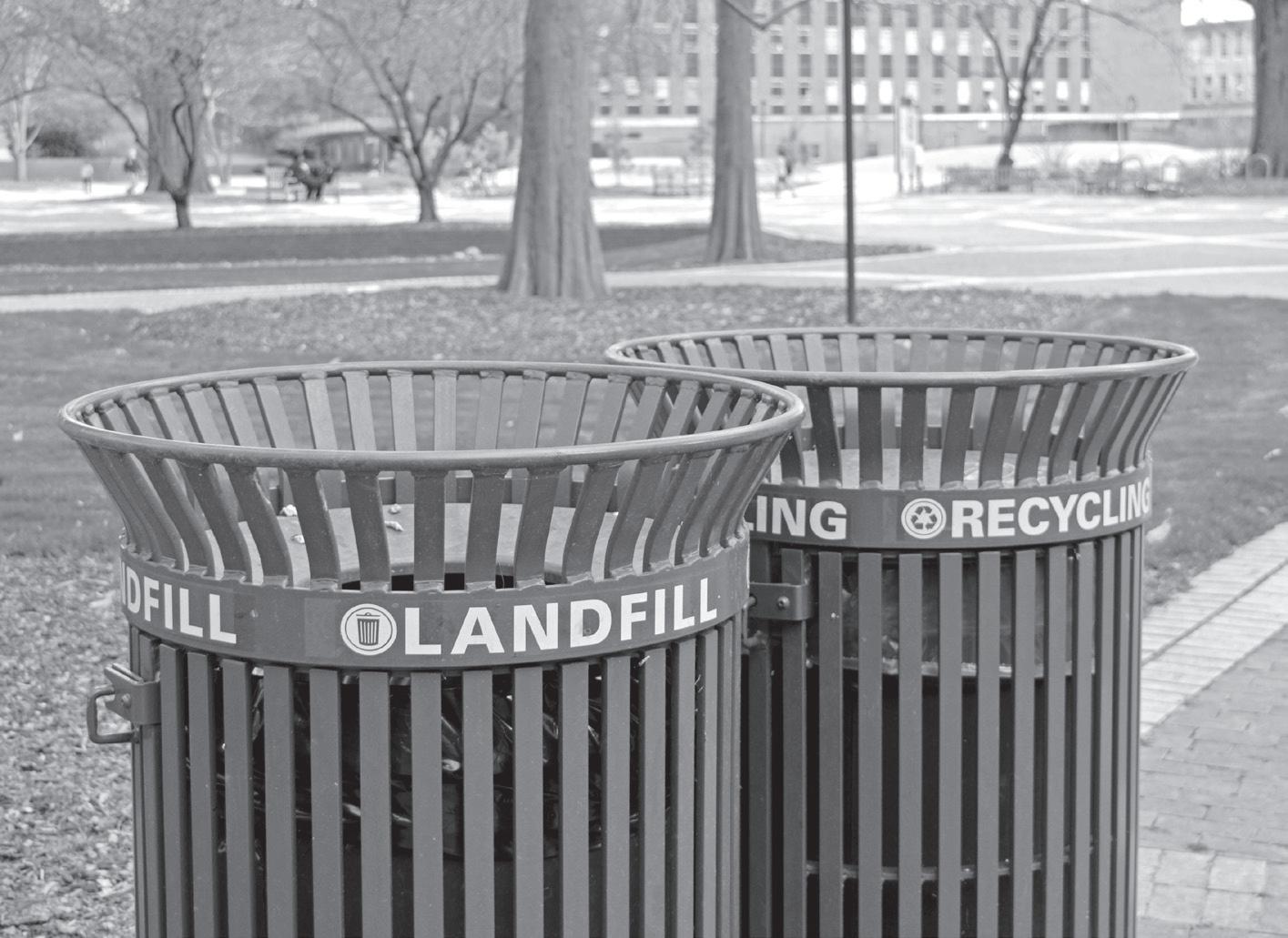
17 minute read
Behind the scenes: Creating course catalog
News
TECHNICIAN
Advertisement
PAGE 3 • THURSDAY, MARCH 28, 2019
Behind the scenes: Creating course catalog
Amber Detwiler
Staff Writer
With enrollment for the fall 2019 term beginning on Wednesday, many students are utilizing tools such as the NC State course catalog in hopes of creating their dream schedules. However, few students are aware of the behind-thescenes process in creating, maintaining and updating the course catalog.
Kyle Pysher, assistant registrar for scheduling, explained how students can best utilize this resource to create their desired schedules.
“The course catalog contains all the information about courses on campus, from how many credit hours they are worth to the course description to when they’re offered,” Pysher said. “There’s a public-facing version that students can use to plan schedules, to know when courses are generally offered, what they are about and how they may fit into their degree program… If students need to research the courses that are listed on their [degree] audit, the course catalog is a great place to do that.”
Jessica Bronchick, assistant registrar for communication, also plays a role in creating the undergraduate catalog, which is a snapshot of all courses available for the given academic year.
“There are two public-facing course catalogs,” Bronchick said. “There’s the one that’s searchable, so students can see in real time all of the class information, so anything about a course that is available in MyPack in the student enrollment system. There’s also the undergraduate catalog website, which is also public, but that is not updated in real time.”
Pysher said that students with additional questions about course content can reach out
CATALOG continued page 5
SCREENSHOT TAKEN FROM MYPACK PORTAL Students can use the Choose Subject dropdown menu to browse courses to add to their Pack Planners.
Despite rumors, fibers program to remain in College of Design
FALSE ADVERTISING CONCERNS ARISE
Rachael Davis
Assistant News Editor for the upcoming semester, students in the College of Design program were blindsided when they noticed there was no fibers studio being offered for the fall term. This caused many students to worry that the fibers program was being cut from the College of Design. However, in a meeting held for College of Design students on March 21 with Pamela Jennings, a professor and head of the Department of Art + Design, she confirmed that the fibers program is not being cut; the fibers studio is just not going to be offered for fall 2019.
Evan Smith, a third-year studying art and design, said that the issue began to unfold when students began to put classes in their registration cart for the upcoming semester.
“[Students] emailed [professors] to ask when the studio was getting posted, because some of the time, classes don’t get posted in a reasonable time,” Smith said in the meeting. “That’s when [a professor] told us it wasn’t happening.”
Smith’s enrollment date has now passed. He said that his graduation has been complicated by the lack of communication between students and professors in relation to the studio class.
“I’m supposed to graduate in the spring, and I wasn’t informed [about the studio],” Smith said in the meeting. “We [students] don’t need to know everything, but it was a little upsetting to be put in a position where I had no idea about my future.”
In the meeting, Jennings suggested that students who will not have a studio for next semester should take elective courses instead.
However, many students, like Morgan Cardwell, a second-year studying art and design, took issue with this solution, stating that most have already fulfilled their elective requirements.
“[Electives] are not really a substitute for studio, because studios are 6 credit hours a semes-
ter; we’re there for at least 12 hours of class time a week, probably 20 hours of free time being used for free time and projects,” Cardwell said. “An elective, a 3-hour class where you work on a project, isn’t really an adequate substitute… because it’s not like studio, where you are really forced to focus on innovation. We are in studio-based majors. Electives are there to teach you new techniques; this is not an adequate substitute. It will not fill up the curriculum.” In addition, Cardwell recognized the lack of resources and faculty in their department, as well as issues with how the two different concentrations, fashion and fibers or animation, in art and design are advertised to students. “In my studio, the two suggested concentrations [are] either fashion and fibers or animation,” Cardwell said. “I started to realize this whole semester, every project we did in the joint studio was animation related. The one project that was planned for [fibers], which was GRAPHIC BY ANNA LEE/TECHNICIAN constructing different backpacks and bags, they switched out with another illustration, animation project, and that’s when we realized there really was no resources available, and we started to really panic.” Jennings also mentioned that students in Art

News
TECHNICIAN
PAGE 4 • THURSDAY, MARCH 28, 2019
Study Abroad program in Prague increases NC State’s presence overseas
Abbies Davies
Correspondent
The NC State European Center in Prague is presently NC State’s only official university presence outside of the United States. With three stories of building space located in the center of Prague, NC State Prague is an attractive option for many students when considering their Study Abroad options.
This year, NC State has experienced the largest increase in Study Abroad participation of NC State’s history, with an increase of attendance by 16 percent, according to Study Abroad’s 2017-18 Year in Review report. The Czech Republic also tops the list of “Top 10 Countries by Student Enrollment” with 231 students.
Heidi Hobbs, transition director of the European Center in Prague, gave some background on the history of NC State Prague and why it is the only overseas center that carries NC State’s name.
“NC State has had a presence in Prague since the mid-1990s,” Hobbs said. “We founded the Prague institute in 2005, and it was associated with the College of Design. In 2017, we became part of the larger university and now are a unit of the Office of Global Engagement. As such, we have opened up a lot of programming that was traditionally design-based to students from all majors.”
Since 2017, NC State Prague has worked to make the facility a viable Study Abroad option for students of all majors and has been successful, as NC State Prague accommodates approximately 200 students in a full calendar year.
“In fall, we have a traditional semester program,” Hobbs said. “Primarily in the fall we have a lot of architecture students come because it’s when we do our architecture courses but we also have general ed as well. Spring traditionally was graphic design but again, because we have diversified, there are a broad range of general ed opportunities and then summer is everything, a lot of GEPs. In a full calendar year, fall, spring, and summer, we will serve about 200 students, give or take.”
One of the emerging programs offered at the NC State European Center in Prague is Prague Connect, an opportunity for students who are admitted for the spring semester to earn credits in Prague during the preceding. The program, which began in fall 2017, consists of 12 credit hours and runs for 90 days.
Depending on the type of program a student wishes to be part of during their time in Prague, prices for the experience range from $3,600-$11,950, with no extra cost to out-ofstate-students.
Ariana Milner, a first-year studying fashion and textile management, was one of 28 students who participated in Prague Connect in fall 2018. Milner spoke about her experiences overseas, including the day-to-day structure of the program.
“We had two groups: the A group and the B group,” Milner said. “Throughout the week we would have two or three classes a day from Monday to Thursday. Afterwards, we would go explore, because we had that whole day to ourselves to discover new things, and we had Fridays off. We got to travel on the weekends, because traveling was really cheap.”
Aside from her course work, Milner learned how to be more independent during her time in Prague.
“It was like being an adult, honestly,” Milner said. “I learned how to be more independent while I was there, obviously, but it was just like we were literally living on our own and figuring everything out by ourselves for the first semester.”
Despite technically attending NC State during the fall, Milner was nervous to join the rest of the NC State community in Raleigh for the spring semester. Ultimately, Milner’s experience in Prague left her wanting more.
For students who are interested in the NC State European Center in Prague can visit their website.

COURTESY OF NC STATE STUDY ABROAD INSTAGRAMCOURTESY OF NC STATE STUDY ABROAD INSTAGRAM
FIBERS
continued from page 3
+ Design do not officially declare a concentration within the department, despite how it may have been advertised to students that they could focus on either animation or fibers.
“There is nothing on your degree that says you have a bachelor’s in art and design in ‘blah blah blah,’” Jennings said in the meeting. “It may be what you came here for, but that’s not what your degree says.”
In response to Jennings, Cardwell said sees the inability to declare a concentration within art and design as an issue. According to Cardwell, the fashion and fibers animation programs have been advertised as two distinct programs from day one.
“It is [how it] is advertised,” Cardwell said. “Students in the past and what I have been putting in my resume is ‘art and design with a concentration in fashion and fibers,’ because they are two very distinct programs. They’re so unique in their own ways and not really interchangeable.” According to Cardwell, as students in Art + Design talked to distinct professors and completed distinct projects, everything was advertised as separate.
“The most frustrating part of this entire ordeal is that they are trying to backtrack on how it was being advertised to us, which makes it feel like they are trying to trick us in a way, or they were giving us false promises for the education we would be getting,” Cardwell said.
In addition, during the meeting, Smith brought up concerns about the program’s budget. He said that he felt the slight cuts made have been an issue and are affecting everyone in the program.
Jennings stated that the budget cuts are effective across the entire university. However, some research departments have a different revenue stream to sponsor and pay for studios.
“Some of our departments are quite prolific in terms of getting sponsorships and corporate nonprofits to be able to support studios,” Jennings said in the meeting. “The Department of Art + Design, historically we have not been there. As the new head of the department, I do have a vision and a focus toward doing more of that for our department as well… But unlike graphic design and industrial design that has a lot of sponsored studios, we don’t. There are various different things that come into play beyond state budgets that help different colleges and departments to be able to support what they do.”
Sharon Joines, associate dean of the College of Design, explained at the meeting that the college doesn’t know how it’s going to calculate its budget for next year.
“They are surprisingly moving targets we’re given,” Joines said in the meeting. “Sometimes we don’t get our budget until September.”
In terms of solutions to the issue at hand, Jennings took into account that students next semester may be allowed to do an independent study or have a joint studio with the Wilson College of Textiles, but no official announcement about a plan has been made. However, a verbal confirmation was made by Jennings at the meeting that there would be a fibers studio in the spring.
Looking at long-term solutions, Jennings said that students and faculty are not currently on the same page about the future of the department, and that must change.
“The long-term solution finding is within the Department of Art + Design,” Jennings said in the meeting. “How do we start to look at our foci and our mission and our vision to make sure that what we do in this department is a) aptly advertised in places where people see descriptions of the department; b) all students and faculty and staff are on the same page of how we are doing that.”
Cardwell said that the entire ordeal has been frustrating because of the sheer lack of communication between students and faculty.
“The lack of transparency, especially when we are investing so much of our time and money and future into this program [is frustrating],” Cardwell said. “It is a public school, not a private school, and there’s nothing private about taxpayer dollars, and that lack of transparency is probably very upsetting to the community as well.”
News
TECHNICIAN
PAGE 5 • THURSDAY, MARCH 28, 2019
Student club, university initiatives aid culture of waste reduction
Paritosh Gaiwak
Staff Writer
In the interest of sustainability, NC State and student clubs have created initiatives to encourage a culture of waste reduction around campus.
NC State is currently in the middle of a fiveyear sustainability plan (2017-2022) to engage the campus community in creating a more sustainable future. This plan contains several sub-goals that collectively bring awareness to this cause.
According to Milannee St. Hill, the outreach coordinator for the Office of Waste Reduction and Recycling, the university views waste as a potential loss of resources.
“Our department is tasked with managing the waste in a responsible way,” St. Hill said. “We have recycling bins everywhere, and the bins are paired. We try to make them as easy as possible and maintain the same standard across the campus, which makes it easy for students to understand.”
St. Hill said that composting is another huge program on campus.
“Our dining halls have been composting back-of-house since 2010,” St. Hill said. “Since 2014-15 we have been expanding composting across campus through development of pizza box composting dumpsters in our residence halls, as pizza boxes cannot be recycled. Students have started initiating and implementing in-room composting in the residence halls.”
Zero Waste Wolves is a student organization that works on waste management on campus.
Kaley Cross, the vice president of Zero Waste Wolves, said that the club started about 18 months ago to work on waste reduction and zero waste education on campus.
“The purpose of the Zero Waste Wolves is to work with campus partners like the waste reduction and recycling office, Talley Student Union, libraries, etc. to find ways to reduce waste on campus,” Cross said. “We also work with other student organizations on campus to educate them as to how they can reduce waste on campus.”
Cross explained that the organization is currently hosting a pilot program from paper towel composting in residence halls.
“For the paper towel composting project, we are being funded by the Sustainability Fund on campus to do that, where we got a grant of about $1000 to do that project,” Cross said.
St. Hill explained that while the Zero Waste Wolves received funding through a sustainability grant to start paper towel composting, the waste management is funded by the university.
“The group has been carrying out training halls in the residence halls on campus focusing on residence halls, which have access to composting dumpsters to allow for all paper towels generated to be taken to composting,” St. Hill said.
Cross said that several big waste management projects have been conducted since the inception of the organization, such as hosting sustainability workshops to promote sustainable living among students.
“We hosted an event last year where we taught people how to make soap,” Cross said. “This year for Earth Month, we are hosting a ‘Sew to Save the Earth’ workshop to teach people how to sew their own facial reusable cotton rounds out of old T-shirts.”
St. Hill explained that the university is working on building its own composting facility.
“We have been able to build our own composting facility and are waiting for final permit,” St. Hill said. “Once we have the permit, we can start managing our compost on site, which would be a true closed-loop system. We are hoping to get it operational within a year.”
St. Hill also shed some light on how the campus managed the huge volume of waste that is generated every day.
“Our office manages all the recycling; we have our own operations,” St. Hill said. “Recycling goes to two material reclamation facilities (MRFs) in Raleigh. Our landfill is taken to a Wake County landfill, and our compost currently is taken to Brooks Contractor, which is based in Goldston, which is one of the few composting facilities that can handle the type and volume of compost we produce.”
According to St. Hill, there are several ways in which students can contribute to waste management on campus.
“First and foremost, students must know what is recyclable and what is not,” St. Hill said. “The information can be found on our website. We are also trying to spread the message that recycling is not based on the product itself as much as it is based on what the MRF can recycle. This is a key factor.”
St. Hill explained that students can also look at the bins, which provide the majority of information on what is recyclable and what is not.
“The most important way in which people can help with waste management is to reduce the waste from the beginning,” St. Hill said. “Recycling cannot solve the waste problems.”
According to St. Hill, shredding and recycling drives take place every year and are open to the public.
“People can bring materials that they want to get shredded along with other waste items such as TVs, plastic bags, etc. to shredding drives,” St. Hill said. “We do presentations for students, staff and faculty. We work closely with other departments which make sustainability a key, [e.g.] athletics. We work closely with several waste management student groups on campus. But the most important thing is that student interest drives waste management.”

CALLA VEAZIE/TECHNICIAN Recycling bins are located next to trashcans around campus, providing easy access to recycling.
CATALOG
continued from page 3
to the department in charge of the course.
“Courses have to go through an approval process,” Pysher said. “They have to go through a committee and be approved for any change in a class. Once it’s approved at those committees, it comes to our office, where the update is actually made in the catalog.”
Pysher said that undergraduate-level courses are approved by the Office of Undergraduate Courses and Curricula, and graduate level courses are approved by the Graduate School.
“For fall 2019, department scheduling officers started making their schedules in December,” Pysher said. “They usually have until early February, before it gets released to us to do the room assignments, before students enroll in March… Basically, when [departments] have that scheduling period, they’re working with professors to figure out what time they can teach the course, if they can teach the course, and then working to determine who’s teaching it when.”
Pysher and Bronchick said that from like term to like term (fall to fall, spring to spring), courses offered are generally similar. However, they said that new courses are being added constantly.
“In terms of the public catalog, our department is working very closely with the Office of Undergraduate Courses and Curricula,” Bronchick said. “We’re working really closely with them to update the public catalog website… really making that more accessible to students and prospective students.”
Bronchick said that the Office of Undergraduate Courses and Curricula is also working on improving the course approval process and the program approval process which would make it easier for faculty and department heads to add and edit courses.
“Scheduling is a very difficult process that is more complicated than most people probably assume,” Pysher said. “The ultimate goal is to create a schedule that works for students.”
To learn more about how to utilize the NC State course catalog and other tools such as degree audit and enrollment wizard, students can visit the Student Services Center website.


